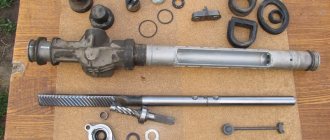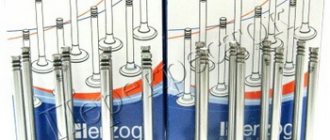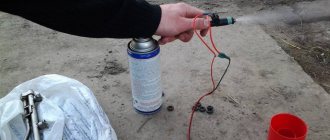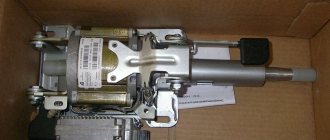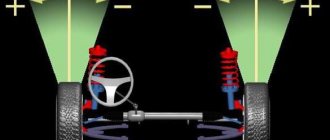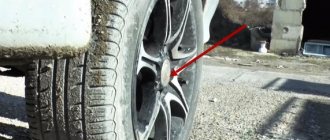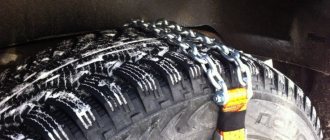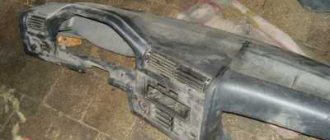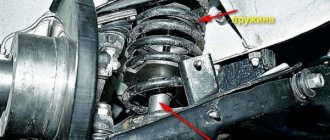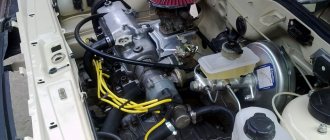Rack and pinion steering mechanisms have significant advantages over other types on relatively light vehicles. These are high control accuracy, simplicity and compactness of design, and the possibility of fairly simple pairing with all classes of power steering.
Reliability and durability are also satisfactory, but largely depend on timely maintenance and adjustment work. One of them is to eliminate by tightening the resulting play in the internal gearing, which is possible on a number of manufactured mechanisms.
When and why do you need to adjust the rack?
To check the unit at service stations, backlash meters are used. But a person can independently determine the correctness of work without equipment.
Signs that the adjusting screw needs to be tightened:
- The presence of extraneous noise in the front suspension when driving on uneven surfaces.
- Deterioration in controllability. It is difficult for the driver to hold the car when moving in a straight line.
- Impacts to the steering wheel when overcoming uneven road surfaces.
- Steering wheel play.
Wedging of the steering wheel when driving indicates wear of the steering rack components. It will not be possible to tighten the adjusting element. It is necessary to identify and replace failed parts.
Adjusting the Kalina steering rack: procedure
Place your hands under the rail from below, from the inside. There you will feel a rubber cap. Remove it - this will make it easier to put the key on. Work carefully because it is not always easy to remove. Next, a special key enters the battle.
Now insert the key into the hole at the bottom. Do not pull too hard, otherwise the part may bite when turning. To avoid backlash and knocking, it is usually enough to turn this nut 30 degrees. That's all.
Of course, if you have a lift or pit, everything is much easier.
How to make adjustments
The principle of operation of the unit is based on the displacement of the bar using a gear. Steering rods are mounted at the edges of the bar. They are connected to wheel mechanisms. When the steering wheel rotates, the gear located on the shaft moves the bar with teeth in the desired direction.
To eliminate play in the rack, the elements of the gear pair are pressed tightly against each other. In this case, the steering wheel rotates freely without applying much physical effort. Surface wear leads to incorrect operation of the unit.
By tightening the adjusting element, the parts of the gear pair are pressed against each other. This makes it possible to eliminate play in the steering rack.
Overtightening the screw leads to strong clamping of the components. In this case, strong friction is formed between them. In this case, free rotation of the steering wheel will be difficult. The wear rate of components will increase. Incorrect adjustment impairs the performance of the steering rack.
Subtleties and nuances of replacing the front suspension silent block, useful tips - read about it here.
How to set up a unit in the garage with your own hands?
Often on forums, car enthusiasts ask the same question about this procedure. Many people do not want to go to a service station and spend money on it for such a simple procedure. People are interested in the algorithm of actions for setting up and tightening. But you need to remember that a tightening may not solve the problem of backlash completely and completely. This is all due to the fact that the transmission pair, namely the rack and gear, has wear. Moreover, this wear is unknown. Adjusting the steering rack will not cause difficulties, but it is important to make a competent and correct diagnosis.
Adjusting the steering mechanism: features
To properly tighten the steering rack, it is better to work together with an assistant. In this case, one person will change the degree of tightening, the second will control the free play of the steering wheel.
It will be necessary to tighten the parts as much as possible without increasing the force required to turn the steering wheel.
The location of the adjusting screw varies from vehicle to vehicle. To identify the part, it is necessary to inspect the mechanism at the junction of the steering shaft and rack. The screw has a locknut that holds it in a stationary position.
To facilitate repairs, the part is cleaned. Stubborn dirt is removed with a wire brush. Specialized chemical compounds are applied to the threads to make turning easier.
On some models, you need a specialized tool to tighten the steering rack.
You can buy keys at the store or make them yourself. This will require experience in welding and turning.
Adjusting the steering wheel play on a VAZ 2101-VAZ 2107
How to Remove Steering Rack Ford Focus 2
Welcome! Steering wheel play is a fairly common problem in almost all cars, especially cars of the “Classic” family. Backlash can occur for various reasons, ranging from a banal collision with a bump and ending with a malfunction in the steering system itself, so in order to remove the backlash you will have to make an effort that you will appreciate in the future.
Note! To adjust the backlash you will need to stock up on: A screwdriver and also a wrench set to “17”!
- Adjusting the free play of the steering wheel
- Additional video clip
What can cause backlash? In fact, it occurs for various reasons, some of which were described above. But if play occurs, this may be to blame: A loose or heavily worn fastening of the steering mechanism, as well as the pendulum arm and the steering rods themselves.
Note! Before sinning on all these items of the steering mechanism, it is first recommended to check and, if possible, correct the increased gap that can be found in the engagement of the roller with the worm of the steering mechanism - we will do this adjustment!
How to adjust play, also known as free play at the steering wheel on a VAZ 2101-VAZ 2107?
Note! It is better to do the work with an assistant, as it is much easier and more convenient!
1) First, remove the protective cap that covers the column adjustment screw.
2) Then loosen the adjusting screw nut (Indicated by the red arrow) using a 17mm wrench. The nut must be loosened until the washer located under this nut can be lifted (Indicated by a blue arrow).
Next, when the nut is loosened, ask your assistant to sit behind the wheel of your car and sharply turn the steering wheel in different directions several times, while using a screwdriver, screw in the adjusting screw, which is indicated by the green arrow.
Note! Do this until the play at the steering wheel is within normal limits. Also, do not over-tighten the adjusting screw, otherwise the steering wheel may become very difficult to turn!
3) Next, completely tighten the adjusting screw nut, which is indicated by the red arrow, and while screwing, use a screwdriver to hold the screw itself from turning it.
Note! After the completed operations, check the free play of the steering wheel; if the steering wheel is difficult to turn, then slightly loosen the adjusting screw by loosening the nut. If, after completing the work, the steering play remains the same or has moved but not significantly, and if turning the steering wheel is accompanied by squeaking and clicking, then have it repaired at a car repair shop or replace the steering mechanism with a new one!
The steering mechanism is a very delicate thing and therefore it is not recommended to repair it yourself, because if assembled incorrectly, the mechanism can jam on the road and therefore the car will stop responding to steering movements!
If you don’t know how to check the steering wheel play, then read the article entitled: “Checking the free play of the steering wheel on a VAZ”!
Additional video clip: You can watch more detailed adjustment of the steering wheel free play in the video clip located just below:
Vaz-Russia.ru
How to adjust the steering rack
To tighten the rack, place the car on a lift. In garage conditions, an overpass or inspection hole is used. To make it easier to turn the wheel mechanisms, the front suspension is unloaded. To do this, jack up the front part of the hull. The work is carried out in the following sequence:
- Place the vehicle on an inspection pit or overpass.
- Avoid spontaneous rolling of the machine. To do this, install anti-roll devices under the rear wheels.
- Raise the front of the car. The degree of elevation is adjusted separately for each case. There is no need to completely lift the wheels off the surface. It is enough to reduce the load on the front axle.
- Inspect the mechanism for damage to parts. If any breakdowns are detected, the components are replaced with new ones.
- Clean the adjustment elements from dirt. If the parts are protected by a plastic plug, remove it. The dismantling method differs for different models. Before starting work, study the operating manual.
- Loosen the locknut that protects the screw from unintentional unscrewing.
- Adjust the degree of pressing of the gear pair. To determine how to properly tighten the steering rack, an assistant inside the car periodically rotates the steering wheel. At the same time, physical effort should not increase.
- Tighten the locknut while holding the screw stationary.
- Place the plastic cap on the seat.
- Lower the car.
- Check the functionality of the mechanism in motion.
If the mechanism jams while the car is moving, complete disassembly of the unit will be required. In this case, it will not be possible to tighten the rail.
How to tighten the steering rack and is it possible to prevent play?
Most often, steering rack malfunctions occur as a result of regular driving on dusty and uneven roads. Speed bumps, which are not always installed according to technology, have especially become a pressing problem in urban conditions; sometimes the entry to them is sharp, sometimes the height is high, and the car suffers. The longer this mode of operation continues, the faster the rack knocking will occur. This is the most pronounced symptom indicating its malfunction.
In order to repair the steering as little as possible, it is necessary to slow down if irregularities are clearly visible on the road. You should drive through them at very low speed.
Other causes of malfunctions are frequent collisions with curbs, a sharp increase in speed when the steering wheel is in the extreme position. In this regard, the load on the gearbox and other components of the steering rack increases. Under such conditions, even the car’s power steering can fail. Rack malfunctions are very similar to other breakdowns, so in some cases it requires complete disassembly for accurate diagnosis.
Ford Focus - how to set up the mechanism?
This process will not take a lot of time and effort. To complete this operation you need about half an hour and a set of keys. Remember that tightening may not solve problems with play and knocking.
It is best to perform operations in a pit, but you can also use a jack.
The tightening is performed using a special screw. It is hidden in the end cap on the steering assembly. Adjust the rack slowly. Don't make too sudden movements. Constantly check the steering wheel movement, as well as play and knocking.
Causes of malfunction and diagnostics
This problem occurs due to:
- damaged anthers;
- a poorly tightened nut that secures the steering wheel to the shaft;
- worn splines on the shaft;
- wear of the universal joint in the steering column;
- poor fastening of the rack to the body;
- tip wear;
- play in the spline connection of the steering shaft;
- wear of rubber-metal parts in the hinges securing the rods.
Anthers
The rail is located in such a place that dirt, salt, water and other “delights” of the road constantly fall on it. The slightest crack in the boot is enough for sand to get inside, acting as an abrasive and water, washing away the factory lubricant.
Consequences of driving with a damaged boot
After a couple of months, the driver notices that the car is handling worse, and even later hears knocking and other sounds near the rack.
It also happens that the ball joint is destroyed due to the drying out of the lubricant over time (in this case, the boot will be intact). To check this, you need to squeeze the boot with your hands and call an assistant to turn the steering wheel left and right. If there is play, the hinge has wear.
The ball joint cannot be restored - only replaced with a new one.
Steering wheel mount
If play in the steering rack occurs due to a poorly tightened nut that holds the steering wheel to the shaft, you can fix the problem yourself. It is enough to remove the decorative casing of the column and tighten the nut with the required force.
Tightening the VAZ steering shaft nut
Important! If the nut that secures the steering wheel to the steering shaft is too loose, the driver may even lose control.
Fastening the rack to the car body
Play in the steering can occur due to weak fastening of the rack to the body or drying out of the silent blocks at the fastening point. To get rid of the problem, you need to tighten the fastening elements or replace the rubber-metal bushings, depending on how worn they are. And yes, if you’re going to get into repairs, it’s better to replace the bushings on both sides, even if the adjacent one is still more or less “alive.”
Backlash in the gear-rack pair
It is formed due to wear of the gear and rasp teeth. Depending on the case, the area between two rack teeth may be flared, or the entire row of teeth on the rasp may be worn out.
Example of rack wear
This usually happens on cars that have traveled a fair amount, with a mileage of 300-350 thousand kilometers. It is impossible to kill the rack at 50 thousand in this way (know this in case they want to sell you a car with a crooked mileage).
Is it possible to remove this gap? Alas, if wear appears on the gears, such a rack cannot be repaired - it is easier and cheaper to replace it with a new one or take it for disassembly.
Popular brands:
Daewoo Matiz, Renault Trafic, Toyota Corolla
Wear of tie rod ends
Particularly dangerous is the backlash that occurs due to the outer tips in the tie rods worn to the limit. This is the weakest link in the helm. There are potholes at every step in our country, and the first blow falls on the tips. Let's add salt, sand and water, which at the slightest destruction of the anther will instantly corrode the working surface. If you do not notice a worn tip in time, the car may completely lose control.
Consequences of driving with a “tired” steering wheel
Are there signs? When the joints wear out, you can hear a characteristic knocking sound when turning the steering wheel and driving through potholes. You can more accurately check the wear of the steering tips on site. But for this you need an assistant who, on command, will rotate the wheels left and right.
We drive the car into the pit (from here there will be the best access to the tips) and grab the tip with our fingers. If an assistant rotates the wheels and the tip is loose, it means it needs to be changed.
It is important to know! Checking the tips is done only when the car is on wheels. This puts the maximum load on the hinge.
What to do if play is detected in the steering rack in this case? Just replace the tips with new ones, on both sides. This work should only be performed by experienced craftsmen and with a puller.
Advice for the future: all parts related to the helm must be of good quality. Don't take China - you'll be tortured to change.
Worn tip
Sometimes there may be play in the bolts that secure the rods to the steering mechanism. To eliminate this, just tighten the bolts with the required force (each model has its own tightening torque).
Steering shaft spline
Depending on the model, this connection can be movable (for example, when the steering wheel is adjusted for reach) or fixed. In the first case, the backlash occurs due to wear in the moving parts, in the second - due to poor tightening of the connection or mechanical damage.
Spline connection
You can check the wear of this part of the shaft yourself by rotating the front wheels from side to side. But it's better to have an assistant. The latter turns the steering wheel, and we look closely at the shaft. You can grab it with your hand and feel how far one part of the shaft moves away from the other. If there is free play, try tightening the nuts. If the steering rack play appears due to the wear of the shaft, alas, nothing can be done. The only way out is to look for a disassembled shaft, removed from a more or less new car.
Toe rods
Another factor leading to play in the steering rack is weak tightening of the rods that regulate wheel toe. If this is not noticed in time, the rods may jump out of the tips.
Camber rods Opel Omega
The swing arms in some car models are not welded to the racks, but are connected with bolts. When a bolted connection weakens over time, play occurs. To check the defect, lift the front of the car, remove the wheels and check how the bolts are tightened. There is free movement - we do a tightening.
Consequences of a malfunction
On Soviet cars, the steering wheel has been “moving” since new. But on modern foreign cars it should be excluded. If you suspect a backlash, contact a diagnostician immediately.
This is how a steering wheel is diagnosed using a backlash meter.
Usually the problem is discovered too late. and to fix it you have to completely change the rack, or make an expensive investment. But that's not so bad. The main danger is losing control and going into a ditch. And the higher the speed, the worse the consequences.
